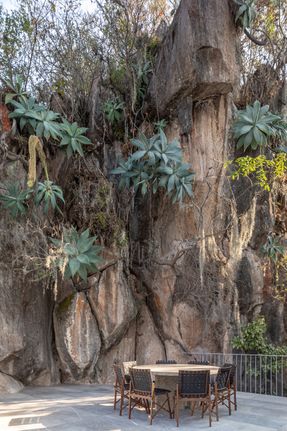ARCHITECTS
Ignacio Urquiza Y Ana Paula De Alba
LEAD ARCHITECTS
Ignacio Urquiza, Ana Paula De Alba
DESIGN TEAM
Michela Lostia, Ana Laura Ochoa, Anet Carmona
INTERIOR DESIGN TEAM
Sacha Bourgarel
YEAR
2022
LOCATION
Valle De Bravo, Mexico
CATEGORY
Houses
Text description provided by architect.
Las Rocas is a complex of four houses in the northern part of Valle de Bravo, known as La Peña. This elevated terrain has outcrops and endemic vegetation.
The 6,400-m2 site was treated as an extension of the adjacent natural reserve, and the project seeks to respect and regenerate this environment.
A detailed and accurate site analysis was essential to determine where to position each house for minimal impact on the preexisting runoffs, rocks, and vegetation.
A narrow cobbled road leads to the complex's central service area, which contains a car park, storerooms, and key installations such as cisterns, machine rooms, and treatment plants.
Users are required to leave their vehicles here and walk to the houses via paths, steps, and small plazas, immediately freeing them from the urban surroundings.
The project evolved from the study of the program: the idea was to create a dynamic system, generating different configurations to optimize compositions for each location.
As a result, the four houses use the same modules and components but with unique layouts depending on their respective characteristics. The volumes are freely arranged in six directions (front, rear, above, below, left, right) in response to their specific situations.
This simple and dynamic system blends the architecture into its natural context. These volumes do not touch each other; their separation creates voids, views, natural light, and ventilation to integrate them adequately within the site.
In Las Rocas, a bathroom can be a stone, a tree a part of the roof, and the terrain itself a walkway or set of steps: nature defines the design.
As with many of our projects, the modules were designed separately in the studio and then mapped out on-site to define their ideal location.
Once positioned, we added the furnishings, imagining the placement of doors and windows before connecting them to the corridor, a linear axis that acts as a horizontal and vertical circulation, with dimensions, measurements, and levels all depending on the location of each volume within the program.
The contrast between the closed volumes and the openness of the corridors is designed to stimulate different sensations when inhabiting these spaces: the enclosure of the sleeping area contrasts with the open circulation routes that relate directly to the local vegetation and rocky landscape.
Apart from linking the different areas, the corridor captures southern light and local heat to regulate the houses' temperature thanks to the shadows thrown by the outcrops and the north-facing orientation of the residences.
The living and dining rooms have a corner window created by a 5 x 10-meter cantilever, opening up the space and directly joining the interior to the exterior.
This design avoids duplicating areas—a common issue in rural retreats in Valle de Bravo—to ensure these rooms are fully used and become core elements of the program.
The kitchen is located in the same space as the dining room and living room, and in some cases, it can be joined to these spaces with a sliding partition.
The terraces were the last piece of the jigsaw: they were plotted on the site to adapt their dimensions to the possibilities of the context and for the landscape to form part of the project, blurring the boundary between construction and the surroundings.
The light-gray stucco finish for Las Rocas matches the predominant hue of the surrounding rocks.
Only two other materials complement the project: textured stone flooring and glass, which is always flush with the exterior façades, matching the walls' smooth texture, in stark contrast to the surroundings, reflecting the surroundings and merging the house within its context.
This color scheme allows a discreet and simple architecture: the composition of the solid volumes creates a sense of lightness; vegetation and nature are kept as the main elements. The houses stand out for their simplicity, creating a quiet built space to bring the context to the fore.
Ana Paula de Alba's custom interior designs for each house respond to the families' specific needs, giving every space a unique character. Each home has its essence, the result of the synergy between user, architecture, and context.






































